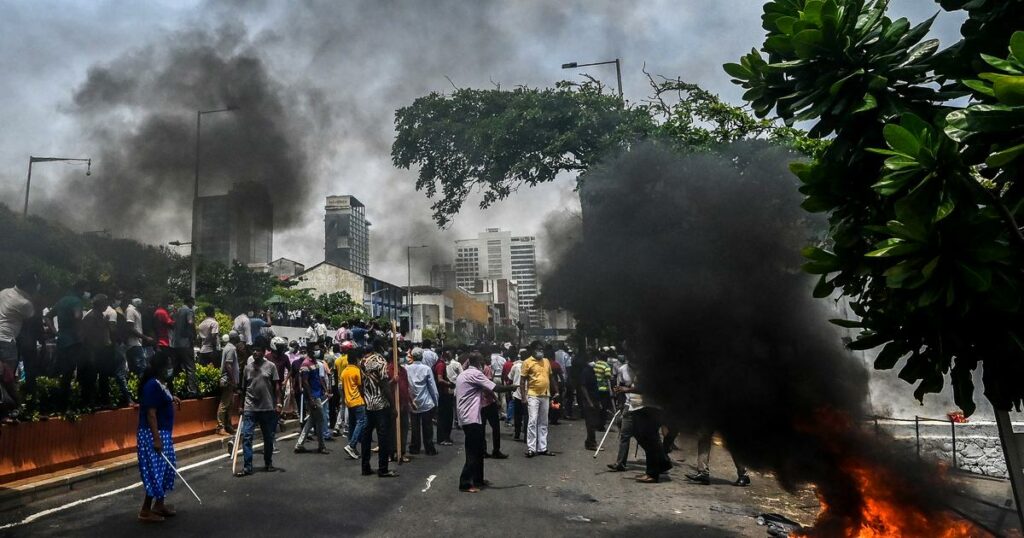Clashes between anti-government protesters and supporters of the prime minister left five people dead and more than 180 injured.
Sri Lankan Prime Minister Mahinda Rajapaksa resigned on Monday, May 9, shortly after clashes between his supporters and anti-government protesters left five dead, including an MP, and more than 180 injured, the deadliest day in three weeks. .
Read alsoSri Lanka: MP commits suicide after shooting protesters, police say
The country has been plagued for several weeks by demonstrations denouncing the government’s inability to cope with shortages of food, fuel and medicine marking the most serious economic crisis it has known since its independence in 1948. Mahinda Rajapaksa, 76 years old , sent his letter of resignation to his younger brother and President Gotabaya Rajapaksa. His departure automatically leads to the dissolution of the firm. « I resign with immediate effect so that you can appoint a multi-party government to lead the country out of the current economic crisis“said the Prime Minister in his letter.
« We were beaten »
The situation did not seem to calm down on Monday evening, especially around his official residence in Colombo, besieged by thousands of anti-government protesters. Shots were fired from the residence after protesters broke down the entrance gate and set fire to a truck parked there, an AFP journalist noted. The police claimed to have fired in the air to repel the attackers from the complex, where Mahinda Rajapaksa was entrenched with supporters. She also fired tear gas canisters at protesters, determined to retaliate after they were attacked earlier in the day by government supporters.
Monday was the deadliest day since the repression of an anti-government demonstration on April 19 in the center of the country (one dead, 24 injured). In Nittambuwa, some 50 kilometers north of the capital, a ruling party MP, Amarakeerthi Athukorala, killed himself after opening fire on two anti-government protesters who were blocking his car, police said. One of the two victims, aged 27, has since succumbed to his injuries, and the MP’s bodyguard has been found dead, police added, without further details.
Read alsoDiplomats call on Sri Lanka to abandon state of emergency
Two other people were killed in the town of Weeraketiya (south), where a member of the ruling party also fired on demonstrators, according to the police. Thousands of supporters of the Rajapaksa brothers, armed with sticks and truncheons, attacked unarmed protesters who had camped outside the president’s office since April 9 to demand his departure on Monday on the capital’s Colombo waterfront. observed by AFP journalists. « We’ve been beaten, the media have been beaten, women and children have been beaten“, told AFP a witness, on condition of anonymity.
“Violence will not solve the current problems”
Police also fired tear gas and used water cannons to disperse protesters, before declaring an immediate, indefinite curfew across the island of 22 million. A total of 181 people have been hospitalized, a spokesman for the city’s national hospital told AFP. Eight other people were injured elsewhere, authorities said. In the south of the island, angry mobs also attacked and completely destroyed the controversial Rajapaksa museum in the family’s ancestral village.
« Violence will not solve the current problems“, tweeted President Rajapaksa, condemning “resolutely violent acts« . « We condemn the violence perpetrated against peaceful protesters today and call on the government to conduct a thorough investigation, including the arrest and prosecution of anyone who incited violence“, underlined, also on Twitter, Julie Chung, the ambassador of the United States, calling for calm.
Read alsoSri Lanka: exports of the famous Ceylon tea collapse
On Friday, President Rajapaksa declared a state of emergency for the second time in five weeks, granting sweeping powers to the security forces, including authorizing them to arrest suspects and detain them for long periods without judicial supervision. It also authorizes the deployment of soldiers to maintain order, in support of the police. This unprecedented economic crisis began after the Covid-19 pandemic, which deprived the country of foreign currency from the tourism sector. The government then banned many imports, causing shortages, galloping inflation and increasingly long power cuts, which fueled anger against the authorities.
SEE ALSO – Sri Lanka: the opposition rejects any national unity and wants the resignation of the president
.

